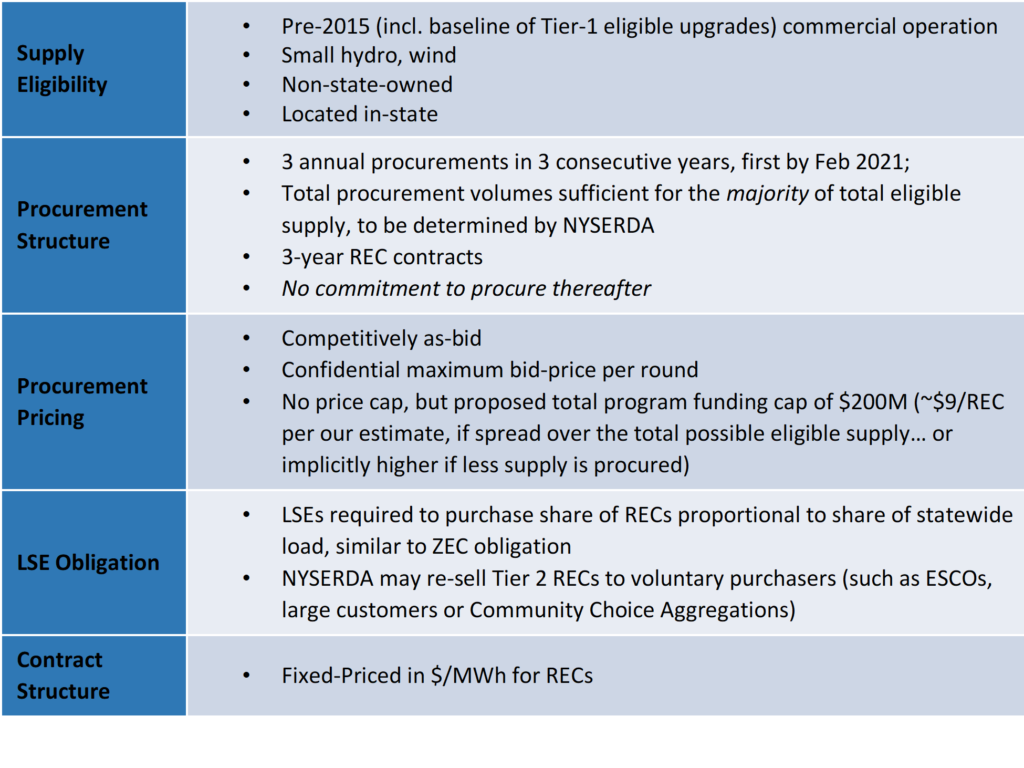Yesterday, October 15, the New York State Public Service Commission (PSC) issued a 306-page Order Adopting Modifications to the Clean Energy Standard, in which the PSC approved significant changes to the state’s Clean Energy Standard (CES) program.
Tier 1 modifications
First and foremost, the Order now incorporates the Climate Leadership and Community Protection Act’s recently codified 70% renewables by 2030 goal into the CES program (up from 50% by 2030). This more ambitious goal requires an increase to the New York State Energy Research and Development Authority’s (NYSERDA’s) Tier 1 Renewable Energy Standard (RES) procurement schedule for new large scale renewable energy projects, up to a flexible target of 4,500 GWh/year. As a reminder, in the first three RES Tier 1 solicitations NYSERDA procured well above its targets of 1,500 GWh/year, sometimes more than double. However, NYSERDA has yet to procure over 3,900 GWh in any given solicitation.
Changes to the Tier 1 procurement evaluation and minimum threshold criteria were also adopted in this Order, designed to result in the selection of projects with a high likelihood of success and portfolios that reflect state objectives, as outlined in the June White Paper.
This Order also approves a temporary decrease to the annual obligations on Load Serving Entities (LSEs) to obtain Tier 1 certificates in proportion to their load. The counterintuitive decrease serves to insulate ratepayers from the initial supply shortfall until targets are better aligned with expected clean energy production. See our July blog post for more Sustainable Energy Advantage insight on the LSE obligation decrease.
In addition, the Order adopts the State’s goal to procure 9 GW of offshore wind by 2035, and authorizes NYSERDA to hold annual solicitations over 2021-2027 for 750 MW to 1,000 MW of offshore wind capacity annually. Importantly, these procurements will not reduce or otherwise impact the Tier 1 land-based procurements schedule.
Tier 2 ultimately established
Another big change to the CES program is the incorporation of a ‘Tier 2’ procurement program to support the state’s fleet of existing renewables. Some may recall that a Tier 2 carveout was suggested by Department of Public Service (DPS) Staff in the original 2016 CES White Paper, but was eventually rejected by the PSC in the Order adopting that program. Also, a Tier 2 program bill (S.23/A.4294) was vetoed by the Governor during the 2019 Legislative Session, coupled with his promise to establish a competitive program to better achieve similar goals in the near future. After years of debate over how to retain existing renewable supply, a Tier 2 program has now been established in New York State.
The PSC largely adopted the program parameters as proposed in NYSERDA’s January Tier 2 Petition. However, after taking public comment, the PSC decided that NYPA’s assets will not be eligible for the Tier 2 program, and NYPA will not have to meet a Tier 2 obligation. The PSC directed NYSERDA to issue a competitive Tier 2 solicitation by February 12, 2021.
Tier 2 program characteristics include:

Tier 4 set to make its debut in 2020
Perhaps the most surprising outcome of the PSC’s Order is the commitment to rapid creation and deployment of a new ‘Tier 4’ for renewable resources injected directly into New York City (NYISO Zone J), distinct from offshore wind procurements. Given some changes or clarifications from NYSERDA’s original proposal, the structure of Tier 4 appears to be primarily focused on stimulating renewables delivery via new transmission, whether from upstate or Canada.
The PSC directed NYSERDA to develop and issue a Tier 4 solicitation by December 14, 2020. However, unlike the Tier 1 procurements, the PSC also required that NYSERDA and DPS Staff file “any agreement for the procurement of Tier 4 RECs” with the PSC for approval.
Tier 4 agreements will be made available for public comment, and the PSC will need to make a determination that the agreement advances the goals of the Tier 4 proposal and is in the public interest, based upon principles incorporated in the PSC’s BCA [Benefit Cost Analysis] Framework Order. The PSC determined that the significantly higher degree of scrutiny for Tier 4 contracts is appropriate because Tier 4 is “an untested concept” and there is uncertainty as to whether the Tier 4 solicitation will result in competitive offers.
This new tier will be especially attractive to developers such as Hydro Québec, who has already expressed its intention to participate in the upcoming solicitation.
Tier 4 program characteristics include:

More actions…
Also of note, in separate actions, the PSC yesterday established criteria for determining priority transmission projects and authorized the “Build-Ready” program. With all of these market shifts, Sustainable Energy Advantage will continue to provide cutting edge analysis on how these changes will impact your opportunities and decisions in NY’s clean energy markets.
A more detailed analysis of the new CES 2.0 will be posted for subscribers to our New York Renewable Energy Market Outlook (NY-REMO) service in the near future – check out that content behind the www.ny-remo.com subscriber portal. Please reach out to Bob Grace at bgrace@seadvantage.com for more information about our subscription services and consulting opportunities.
